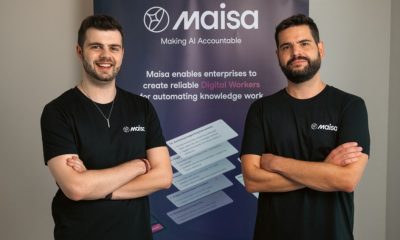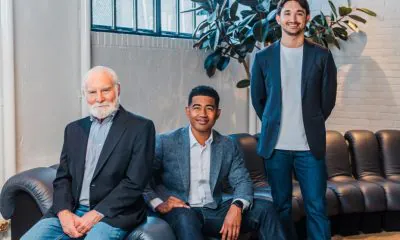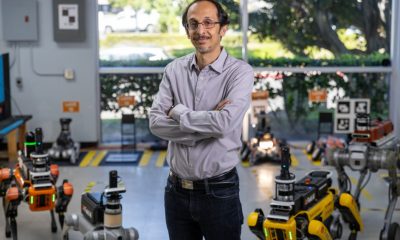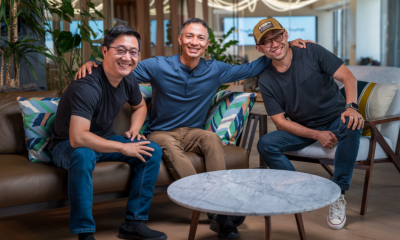Funding
XPANCEO Raises $250M to Launch the World’s First AI-Powered Smart Contact Lens

The UAE’s newest unicorn is skipping the headset era and stepping straight into an invisible, AI-enhanced future with a state-of-the-art contact lens. XPANCEO has raised $250 million at a $1.35 billion valuation to bring its revolutionary smart contact lenses to market. The deep tech company—now officially the UAE’s 12th unicorn—aims to eliminate smartphones, smartwatches, and AR glasses altogether by building an invisible interface for extended reality (XR) and AI-powered personal computing.
While major players like Apple, Meta, and Google are still experimenting with headsets and glasses, XPANCEO is bypassing bulky form factors entirely. Its contact lenses are thinner than a human hair, yet capable of delivering immersive AR vision, health monitoring, night vision, zoom, wireless connectivity, and more—all directly through the eye.
“In just 24 months, we’ve built 15 functional prototypes, each unlocking a new level of human-tech integration,” said Roman Axelrod, Founder and Managing Partner of XPANCEO, in a recent interview with Unite.ai. “The idea is to merge all personal devices into one seamless experience—your eyes.”
The End of Screens? The Rise of XR Lenses
XPANCEO’s flagship innovation is what it calls the “ultimate form factor” for computing: a smart contact lens powered by an embedded AI agent and capable of XR (Extended Reality)—a spectrum of immersive experiences blending the physical and digital worlds.
Rather than projecting content onto a phone or display, XPANCEO’s lens places information directly into the user’s field of vision, adapting to their environment in real time. The device enables:
- Augmented Reality (AR) overlays directly on the retina
- Intraocular Pressure (IOP) monitoring for glaucoma detection
- Real-time biometric sensing through tear fluid—measuring glucose, hydration, and stress levels
- Night vision and zoom functionality via nanoparticle optics
- Wireless data transfer and AI-powered inference onboard
“The lens acts as a sensor, a display, and an AI interface all in one. It’s not just wearable tech—it’s integrated cognition.” – Dr. Valentyn S. Volkov, Scientific Co-Founder.
This technology represents the convergence of AI, optics, bio-integration, and nanotechnology. The company’s prototypes leverage novel materials and nano-optics to manipulate light at the sub-wavelength level, allowing for dynamic imaging and sensor fusion within the eye itself.
A Platform for the Post-Smartphone Era
The new funding round, led by Opportunity Venture (Asia), follows a $40 million seed round and will accelerate XPANCEO’s path to market. The company has grown rapidly, doubling its staff to over 100 experts and expanding its R&D facilities. It now collaborates with global institutions such as the University of Dubai, the University of Manchester, and the National University of Singapore to stay on the cutting edge of material science, optics, and human-computer interaction.
“XPANCEO isn’t building a gadget,” said Philip Ma, Managing Director of Opportunity Venture. “They’re creating the next interface layer between humans and machines.”
From a technological perspective, XPANCEO’s approach relies on AI-assisted R&D workflows to iterate faster on materials, device architecture, and user interfaces. The company has contributed to 110 scientific publications and holds a growing portfolio of patents related to its lens architecture and biosensing capabilities.
Human-Centered AI: A Strategic Collaboration with Academia
XPANCEO’s recent MoU with the University of Dubai reflects its vision to cultivate local talent and build a future-facing innovation ecosystem. Students and researchers will have direct access to live R&D in fields like nanomaterials, optics, and bioelectronics.
This strategic partnership supports the UAE’s broader ambitions in emerging technology, fostering co-authored publications, internship pipelines, and applied research in immersive learning and healthcare use cases.
“We don’t just develop deep tech, we help grow the minds that will define tomorrow’s breakthroughs.” – Dr. Valentyn S. Volkov.
What This Means for the Industry
XPANCEO’s vision reimagines how we interact with technology—not through screens or peripherals, but through biocompatible, AI-powered interfaces embedded in our daily perception. This radically changes the trajectory of personal computing:
- Accessibility: Smart lenses could deliver enhanced vision or AR to users without needing headsets or smartphones.
- Healthcare: Continuous biometric data from the eye could provide unprecedented early detection of diseases like diabetes and glaucoma.
- Ubiquity: With no visible hardware, users can access the power of AI and connectivity without distraction or friction.
- Security & Privacy: Decentralized data processing via edge AI in the lens may reduce reliance on cloud services and improve user control.
The contact lens as a platform marks a step toward what many futurists have called “invisible computing”—where technology adapts to us, rather than the other way around.
Looking Ahead: The Future of XR Through the Eye
XPANCEO’s breakthrough signals a shift in how we might experience extended reality in the years ahead—not through headsets or bulky glasses, but through something as subtle and personal as a contact lens.
While today’s XR market is largely defined by devices worn over the face, smart contact lenses offer a radically different path: one that’s discreet, immersive, and biologically integrated. This approach could overcome many of the barriers facing VR and AR adoption—comfort, social acceptability, mobility—by embedding the experience directly into vision itself.
If XPANCEO and others in the field succeed, the future of augmented reality may not be tethered to hardware at all. Instead, it could be built around seamless, sensor-rich interfaces that enable computing to exist wherever the human eye looks. The implications stretch from personal computing to healthcare, education, the future of work via cloud computing, and how we navigate the world itself.












